Stay Safe With This Spring Auto Repair Checklist

Winter can be rough on your car, but now that the cold months are behind us, it’s time for a spring auto repair checklist to get your ride back in top shape. Road salt, freezing temperatures, and potholes take a toll on key components, so a proper checkup is a must. A little vehicle maintenance now can prevent costly repairs later.
With the changing seasons, you’ll want to focus on car safety inspection and performance checks to keep your vehicle road-ready. Tire pressure, fluid levels, and other key steps in this guide will help extend the life of your car. Don’t wait for a breakdown, take action now and keep your drives smooth and safe.
What Should Be Included in a Spring Auto Repair Checklist?
- Check and rotate tires – Cold temperatures affect tire pressure, so check for proper inflation and rotate them for even wear.
- Inspect brakes – Brake pads and rotors may have worn down due to winter driving conditions.
- Test battery health – Extreme temperatures can weaken your battery, so check its charge and terminals.
- Replace windshield wipers – Spring showers call for fresh, streak-free wipers for clear visibility.
- Top off fluids – Check and refill oil, coolant, brake fluid, and windshield washer fluid.
- Inspect belts and hoses – Cracks or wear can lead to breakdowns, so replace any damaged components.
- Check alignment and suspension – Potholes from winter can throw off alignment, causing uneven tire wear.
Essential Spring Auto Repair Checklist for a Safe Ride
1. Change Your Oil and Filter
- Check your owner’s manual for the recommended oil type and change interval.
- Look for signs of dirty oil, such as a dark, sludgy appearance.
- Replace the oil filter to prevent contaminants from circulating in your engine.
2. Test Your Battery and Electrical System
- Check battery terminals for corrosion and clean them with a wire brush.
- Use a multimeter to test voltage; anything below 12.4V may indicate a weak battery.
- If your battery is over three years old, consider a professional test or replacement.
3. Inspect Your Tires for Wear and Proper Inflation
- Use a tread depth gauge to check that tire tread is at least 2/32 of an inch.
- Inspect for bulges, cracks, or punctures that could lead to a blowout.
- Inflate all tires to the manufacturer’s recommended pressure for better fuel economy.
4. Check and Refill Essential Fluids
- Coolant: Prevents overheating as temperatures rise.
- Brake Fluid: Maintains stopping power and should be free of air bubbles.
- Transmission Fluid: Ensures smooth gear shifts and prevents damage.
- Power Steering Fluid: Helps with smooth steering and should be at the correct level.
5. Inspect and Clean Your Braking System
- Listen for squeaking or grinding noises when braking—these indicate worn pads.
- Check brake rotors for warping or excessive wear.
- Have a mechanic test brake fluid and replace it if contaminated.
6. Replace or Clean Your Air Filters
- Check both the engine air filter and cabin air filter for dirt buildup.
- Replace the filters if they appear clogged or excessively dirty.
- A clean air filter improves fuel efficiency and ensures fresh, clean air inside your car.
7. Inspect Belts and Hoses for Cracks or Wear
- Look for visible cracks, fraying, or bulging in belts.
- Squeeze hoses gently—if they feel brittle or too soft, they need replacing.
- Ensure all connections are secure to prevent coolant or oil leaks.
8. Clean and Protect Your Exterior and Undercarriage
- Wash your car thoroughly, including the wheel wells and underbody.
- Apply a protective wax coat to shield your paint from sun damage.
- Inspect for small rust spots and treat them before they spread.
9. Test Your Lights and Wipers for Visibility
- Turn on headlights, brake lights, and turn signals to check for dim or burnt-out bulbs.
- Replace windshield wipers if they streak, squeak, or leave smudges.
- Ensure your washer fluid is full for quick cleaning on rainy days.
10. Check Your Suspension and Alignment
- If your car pulls to one side, it may need an alignment adjustment.
- Listen for unusual clunking or bouncing, which could signal worn-out shocks or struts.
- Get a professional car safety inspection to ensure your suspension is in good condition.
Why a Car Safety Inspection Is Crucial in Spring
1. Suspension and Alignment Check
- Inspect shocks and struts for leaks or damage.
- Check for uneven tire wear, which indicates alignment issues.
- Get a professional alignment if your car’s steering feels off.
2. Exhaust System Inspection
- Check for rusted or damaged pipes underneath the car.
- Listen for loud noises when accelerating, which could indicate an exhaust leak.
- Replace worn-out mufflers or catalytic converters to maintain performance.
3. Windshield and Wiper Blade Replacement
- Replace wiper blades if they leave streaks or squeak against the glass.
- Check for windshield chips or cracks that could spread over time.
- Refill windshield washer fluid to remove dirt and pollen buildup.
Spring Auto Repair Checklist for a Safer Drive
Keeping up with your spring auto repair checklist ensures your vehicle stays in top condition for the warmer months. A little effort now can prevent major issues later.
Regular car safety inspection and maintenance improve performance, extend lifespan, and keep you safe on the road. Don’t overlook these essential steps—your car (and your wallet) will thank you.
Contact HEART Auto Care for expert car maintenance and repairs. Their team is ready to help with all your spring auto repair checklist needs. Schedule your service today by visiting Contact HEART Auto Care.
What HEART Offers
Servicing Your Vehicle Has Never Been Easier
2 Year Warranty
Free Loaner Cars
98% Same Day Service
Transparent Pricing
Finance Options
Certified Technicians
Free Digital Inspection













